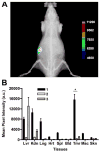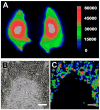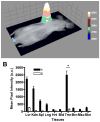Optical imaging of mammary and prostate tumors in living animals using a synthetic near infrared zinc(II)-dipicolylamine probe for anionic cell surfaces
- PMID: 20014845
- PMCID: PMC2805267
- DOI: 10.1021/ja908467y
Optical imaging of mammary and prostate tumors in living animals using a synthetic near infrared zinc(II)-dipicolylamine probe for anionic cell surfaces
Abstract
In vivo optical imaging shows that a fluorescent imaging probe, comprised of a near-infrared fluorophore attached to an affinity group containing two zinc(II)-dipicolylamine (Zn-DPA) units, targets prostate and mammary tumors in two different xenograft animal models. The tumor selectivity is absent with control fluorophores whose structures do not have appended Zn-DPA targeting ligands. Ex vivo biodistribution and histological analyses indicate that the probe is targeting the necrotic regions of the tumors, which is consistent with in vitro microscopy showing selective targeting of the anionic membrane surfaces of dead and dying cells.
Figures




Similar articles
-
Deep-red fluorescent imaging probe for bacteria.Bioorg Med Chem Lett. 2012 Apr 15;22(8):2833-6. doi: 10.1016/j.bmcl.2012.02.078. Epub 2012 Mar 3. Bioorg Med Chem Lett. 2012. PMID: 22424976 Free PMC article.
-
Enhanced cell death imaging using multivalent zinc(II)-bis(dipicolylamine) fluorescent probes.Mol Pharm. 2013 Sep 3;10(9):3296-303. doi: 10.1021/mp300720k. Epub 2013 Aug 5. Mol Pharm. 2013. PMID: 23915311 Free PMC article.
-
Phenoxide-Bridged Zinc(II)-Bis(dipicolylamine) Probes for Molecular Imaging of Cell Death.Bioconjug Chem. 2016 Feb 17;27(2):363-75. doi: 10.1021/acs.bioconjchem.5b00447. Epub 2015 Sep 11. Bioconjug Chem. 2016. PMID: 26334386 Free PMC article.
-
Library synthesis, screening, and discovery of modified Zinc(II)-Bis(dipicolylamine) probe for enhanced molecular imaging of cell death.Bioconjug Chem. 2014 Apr 16;25(4):724-37. doi: 10.1021/bc500003x. Epub 2014 Mar 13. Bioconjug Chem. 2014. PMID: 24575875 Free PMC article.
-
Anion recognition and sensing with Zn(II)-dipicolylamine complexes.Chem Soc Rev. 2012 Jul 21;41(14):4928-65. doi: 10.1039/c2cs35087d. Epub 2012 Jun 12. Chem Soc Rev. 2012. PMID: 22688834 Review.
Cited by
-
Semi-automatic synthesis and biodistribution of N-(2-18F-fluoropropionyl)-bis(zinc (II)-dipicolylamine) (18F-FP-DPAZn2) for AD model imaging.BMC Med Imaging. 2017 Apr 21;17(1):27. doi: 10.1186/s12880-017-0200-1. BMC Med Imaging. 2017. PMID: 28431519 Free PMC article.
-
Near Infrared Fluorescence Imaging in Nano-Therapeutics and Photo-Thermal Evaluation.Int J Mol Sci. 2017 Apr 28;18(5):924. doi: 10.3390/ijms18050924. Int J Mol Sci. 2017. PMID: 28452928 Free PMC article. Review.
-
Selective non-covalent triggered release from liposomes.Chem Commun (Camb). 2012 Aug 21;48(65):8123-5. doi: 10.1039/c2cc32962j. Epub 2012 Jul 9. Chem Commun (Camb). 2012. PMID: 22772732 Free PMC article.
-
A nanoparticle formula for delivering siRNA or miRNAs to tumor cells in cell culture and in vivo.Nat Protoc. 2014 Aug;9(8):1900-15. doi: 10.1038/nprot.2014.128. Epub 2014 Jul 17. Nat Protoc. 2014. PMID: 25033207 Free PMC article.
-
Avenues to molecular imaging of dying cells: Focus on cancer.Med Res Rev. 2018 Sep;38(6):1713-1768. doi: 10.1002/med.21495. Epub 2018 Mar 12. Med Res Rev. 2018. PMID: 29528513 Free PMC article. Review.
References
-
- Kulasingam V, Diamandis EP. Nat Clin Pract Oncol. 2008;5:588–599. - PubMed
-
- Elliot JI, Surprenant A, Marelli-Berg FM, Cooper JC, Cassady-Cain RL, Wooding C, Linton K, Alexander DR, Higgins CF. Nat Cell Biol. 2005;8:808–816. - PubMed
-
- Ran S, Downes A, Thorpe PA. Cancer Res. 2002;62:6132–6140. - PubMed
-
- Distler JHW, Huber LC, Reich CF, III, Gay S, Distler O, Pisetsky DS. Apoptosis. 2005;10:731–741. - PubMed
Publication types
MeSH terms
Substances
Grants and funding
LinkOut - more resources
Full Text Sources
Other Literature Sources
Medical

